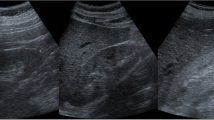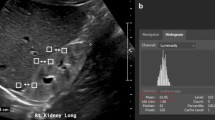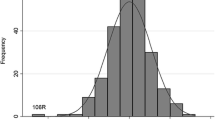Abstract
Purpose
Ultrasonography (US) is an inexpensive, noninvasive and easy imaging procedure to comment on the kidney disease. Data are limited about the relation between estimated glomerular filtration rate (e-GFR) and all 3 renal US parameters, including kidney length, parenchymal thickness and parenchymal echogenicity, in chronic kidney disease (CKD). In this study, we aimed to investigate the association between e-GFR and ultrasonographic CKD score calculated via these ultrasonographic parameters.
Methods
One hundred and twenty patients with stage 1–5 CKD were enrolled in this study. The glomerular filtration rate was estimated by the Chronic Kidney Disease Epidemiology Collaboration equation. US was performed by the same radiologist who was blinded to patients’ histories and laboratory results. US parameters including kidney length, parenchymal thickness and parenchymal echogenicity were obtained from both kidneys. All 3 parameters were scored for each kidney, separately. The sum of the average scores of these parameters was used to calculate ultrasonographic CKD score.
Results
The mean age of patients was 63.34 ± 14.19 years. Mean kidney length, parenchymal thickness, ultrasonographic CKD score and median parenchymal echogenicity were found as 96.2 ± 12.3, 10.97 ± 2.59 mm, 6.28 ± 2.52 and 1.0 (0–3.5), respectively. e-GFR was positively correlated with kidney length (r = 0.343, p < 0.001), parenchymal thickness (r = 0.37, p < 0.001) and negatively correlated with CKD score (r = −0.587, p < 0.001) and parenchymal echogenicity (r = −0.683, p < 0.001). Receiver operating characteristic curve analysis for distinction of e-GFR lower than 60 mL/min showed that the ultrasonographic CKD score higher than 4.75 was the best parameter with the sensitivity of 81% and positive predictivity of 92% (AUC, 0.829; 95% CI, 0.74–0.92; p < 0.001).
Conclusion
We found correlation between e-GFR and ultrasonographic CKD score via using all ultrasonographic parameters. Also, our study showed that ultrasonographic CKD score can be useful for distinction of CKD stage 3–5 from stage 1 and 2. We suggested that the ultrasonographic CKD score provided more objective data in the assessment of CKD.







Similar content being viewed by others
References
Summary of recommendation statements (2013) Kidney Int Suppl (2011) 3(1):5–14
Muto NS, Kamishima T, Harris AA, Kato F, Onodera Y, Terae S, Shirato H (2011) Renal cortical volume measured using automatic contouring software for computed tomography and its relationship with BMI, age and renal function. Eur J Radiol 78(1):151–156
Widjaja E, Oxtoby JW, Hale TL, Jones PW, Harden PN, McCall IW (2004) Ultrasound measured renal length versus low dose CT volume in predicting single kidney glomerular filtration rate. Br J Radiol 77(921):759–764
Herts BR, Sharma N, Lieber M, Freire M, Goldfarb DA, Poggio ED (2009) Estimating glomerular filtration rate in kidney donors: a model constructed with renal volume measurements from donor CT scans. Radiology 252(1):109–116
O’Neill WC (2000) Sonographic evaluation of renal failure. Am J Kidney Dis 35(6):1021–1038
Emamian SA, Nielsen MB, Pedersen JF, Ytte L (1993) Kidney dimensions at sonography: correlation with age, sex, and habitus in 665 adult volunteers. AJR Am J Roentgenol 160(1):83–86
Jones TB, Riddick LR, Harpen MD, Dubuisson RL, Samuels D (1983) Ultrasonographic determination of renal mass and renal volume. J Ultrasound Med 2(4):151–154
Van Den Noortgate N, Velghe A, Petrovic M, Vandewiele C, Lameire N, Voet D, Afschrift M (2003) The role of ultrasonography in the assessment of renal function in the elderly. J Nephrol 16(5):658–662
Bakker J, Olree M, Kaatee R, de Lange EE, Moons KG, Beutler JJ, Beek FJ (1999) Renal volume measurements: accuracy and repeatability of US compared with that of MR imaging. Radiology 211(3):623–628
Khati NJ, Hill MC, Kimmel PL (2005) The role of ultrasound in renal insufficiency: the essentials. Ultrasound Q 21(4):227–244
Levey AS, Stevens LA, Schmid CH, Zhang YL, Castro AF, Feldman HI, Kusek JW, Eggers P, Van Lente F, Greene T et al (2009) A new equation to estimate glomerular filtration rate. Ann Intern Med 150(9):604–612
Stevens LA, Schmid CH, Greene T, Zhang YL, Beck GJ, Froissart M, Hamm LL, Lewis JB, Mauer M, Navis GJ et al (2010) Comparative performance of the CKD epidemiology collaboration (CKD-EPI) and the modification of diet in renal disease (MDRD) study equations for estimating GFR levels above 60 mL/min/1.73 m2. Am J Kidney Dis 56(3):486–495
Roger SD, Beale AM, Cattell WR, Webb JA (1994) What is the value of measuring renal parenchymal thickness before renal biopsy? Clin Radiol 49(1):45–49
Lucisano G, Comi N, Pelagi E, Cianfrone P, Fuiano L, Fuiano G (2015) Can renal sonography be a reliable diagnostic tool in the assessment of chronic kidney disease? J Ultrasound Med 34(2):299–306
Moghazi S, Jones E, Schroepple J, Arya K, McClellan W, Hennigar RA, O’Neill WC (2005) Correlation of renal histopathology with sonographic findings. Kidney Int 67(4):1515–1520
Miletić D, Fuckar Z, Sustić A, Mozetic V, Stimac D, Zauhar G (1998) Sonographic measurement of absolute and relative renal length in adults. J Clin Ultrasound 26(4):185–189
Sustić A, Mavrić Z, Fuckar Z, Miletić D, Mozetic V, Mlinarić B (1998) Kidney length in postoperative acute renal failure. J Clin Ultrasound 26(5):251–255
Beland MD, Walle NL, Machan JT, Cronan JJ (2010) Renal cortical thickness measured at ultrasound: is it better than renal length as an indicator of renal function in chronic kidney disease? AJR Am J Roentgenol 195(2):W146–W149
Siddappa JK, Singla S, Al Ameen M, Rakshith SC, Kumar N (2013) Correlation of ultrasonographic parameters with serum creatinine in chronic kidney disease. J Clin Imaging Sci 3:28
O’Neill WC (2015) Radiologic assessment of renal disease. In: Curhan GC (ed) UpToDate. UpToDate, Waltham
Päivänsalo M, Huttunen K, Suramo I (1985) Ultrasonographic findings in renal parenchymal diseases. Scand J Urol Nephrol 19(2):119–123
Segel MC, Lecky JW, Slasky BS (1984) Diabetes mellitus: the predominant cause of bilateral renal enlargement. Radiology 153(2):341–342
Adibi A, Adibi I, Khosravi P (2007) Do kidney sizes in ultrasonography correlate to glomerular filtration rate in healthy children? Australas Radiol 51(6):555–559
Author information
Authors and Affiliations
Corresponding author
Ethics declarations
Conflict of interest
The authors have no conflicts of interest to declare.
Ethical approval
All procedures performed in studies involving human participants were in accordance with the ethical standards of the institutional and/or national research committee and with the 1964 Declaration of Helsinki and its later amendments or comparable ethical standards.
Rights and permissions
About this article
Cite this article
Yaprak, M., Çakır, Ö., Turan, M.N. et al. Role of ultrasonographic chronic kidney disease score in the assessment of chronic kidney disease. Int Urol Nephrol 49, 123–131 (2017). https://doi.org/10.1007/s11255-016-1443-4
Received:
Accepted:
Published:
Issue Date:
DOI: https://doi.org/10.1007/s11255-016-1443-4




